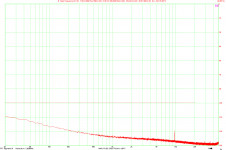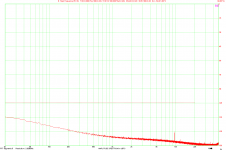I think the most likely explanation is that you have 25dB or more of high frequency hearing loss.
That is certainly a possibility.
Well, still haven't got an answer on what the problem with the Realtek is - the chip used is the ALC262, which handles 24 bit, at 48,96,192 native rates. Only in the case of 44.1 input does the controller have to resample - so if the latter is poor at this function, then resample offline to a multiple of 48. Spec'd signal to noise is not brilliant, 100dB, but when the hardware is functioning as it should it does a clean ramping of a -90dB signal.
According to the ALC262 product page:
So there's nothing stopping the hardware from giving bit-perfect output.
All DACs support 44.1k/48k/96k/192kHz sample rate
All ADCs support 44.1k/48k/96kHz sample rate
Applicable for DVD-Audio solutions
16/20/24-bit S/PDIF-OUT supports 44.1k/48k/96k/192kHz sample rate
16/20/24-bit S/PDIF-IN supports 44.1k/48k/96k/192kHz sample rate
So there's nothing stopping the hardware from giving bit-perfect output.
Last edited:
Well, to do that properly requires a "high-quality reference sound card" - if I had one on hand I would be using that for the playback listening ...
Otherwise there may be some way to do a loopback, which considering there's a single chip in the scenario is almost guaranteed to give pretty dreadful results - my laptop has a dead audio chip ... there's another laptop which may do a reasonable job, but I'm not that familiar with it, how good its audio ADC is ...
Otherwise there may be some way to do a loopback, which considering there's a single chip in the scenario is almost guaranteed to give pretty dreadful results - my laptop has a dead audio chip ... there's another laptop which may do a reasonable job, but I'm not that familiar with it, how good its audio ADC is ...
I have come to conclusion that it would be useless, based on discussions we have had in last 2 weeks.
But aren't these tests at the lsb level equally useless?I have come to conclusion that it would be useless, based on discussions we have had in last 2 weeks.
I think we can do some different kind of tests, that will be of more value.
This video has some experiments in them that everyone can do at home.
(It also features JJ Johnson, the guy I recommended to you about the filter bands in our ears. He is the nr1 authority on perceptual codecs in the world.)
Audio Myths Workshop - YouTube
Soundfiles here:
AES Workshop Video Files
Ground loop obsessions
Regarding ground loop obsessions, I am attaching two measurements, one with ground loop and one without ground loop. Can you tell me which is which?
I've drawn a picture of my ground loop hypothesis to try to make it clearer.
It's consistent with all my observations and I've successfully used it to fix the sound of my amp. That doesn't necessarily mean it's the real explanation of what has been going on in my system though.
Regarding ground loop obsessions, I am attaching two measurements, one with ground loop and one without ground loop. Can you tell me which is which?
Attachments
Regarding ground loop obsessions, I am attaching two measurements, one with ground loop and one without ground loop. Can you tell me which is which?
Left with ground loop. Are you sure it is not audible?
Regarding ground loop obsessions, I am attaching two measurements, one with ground loop and one without ground loop. Can you tell me which is which?
Can't tell. If you say there is one and I had to guess, would also say left.
Normally, I get 1M sample FFTs and plot them with lines in a spreadsheet. This normally has enough resolution to be able to tell conclusively.
These plots might be from a system that sounds good perhaps.
I would never expect a system with a plot like the noise plot from Z to sound good though.
Soundfiles here:But aren't these tests at the lsb level equally useless?
I think we can do some different kind of tests, that will be of more value.
This video has some experiments in them that everyone can do at home.
(It also features JJ Johnson, the guy I recommended to you about the filter bands in our ears. He is the nr1 authority on perceptual codecs in the world.)
Audio Myths Workshop - YouTube
Excellent link. Thanks mohammed.
I think I heard Poppy do this at AES San Francisco 2008.
Anyone/everyone doing Listening Tests needs to study this carefully.
You critics feel free to do some job yourself. Still waiting, expecting time that limits to infinity. So easy to criticize.
Last edited:
Pavel, sorry to add some more distraction, and negativity to the situation, but I wanted to at least get some more clarity on what was possible - I immediately had misgivings about RMAA, and this link mentions these, plus much, much more: NwAvGuy: RightMark Audio Analyzer
I've made a file with increasing levels of noise added to music.
The music itself has a average RMS level of -17.6dB with peaks at -7.9dB.
Here's the file:
Zippyshare.com - Test file 1.rar
When can you hear the noise?
Edit: Noise levels go from -90dB and every 5 seconds 5dB extra noise is added.
The music itself has a average RMS level of -17.6dB with peaks at -7.9dB.
Here's the file:
Zippyshare.com - Test file 1.rar
When can you hear the noise?
Edit: Noise levels go from -90dB and every 5 seconds 5dB extra noise is added.
Last edited:
Thanks for putting that up, mohammed li. Interesting test, what made the noise become noticeable was tuning into the brushwork - the noise, and the dragging of the brushes on the drum surface match in character, so when the tonality of the latter significantly alters the noise is becoming noticeable. After 15 secs in, without getting too anal about it, the change can be noted - if I really stressed about it, I might be able to do the 10-15 range ...
Well my Jurassic tests 1980 were below the LSB level.But aren't these tests at the lsb level equally useless?
The significance is that my true golden pinnae could pick up the difference reliably even with 'pop' on DBLT bla bla though they couldn't describe it properly when listening at 'normal' levels.
The -20dBLSB tests were done to investigate this and provide IMHO (and those of my true golden pinnae) sufficient explanation for their performance.
I've made a file with increasing levels of noise added to music.
Can't try right now. The nature of the noise is also very significant: random noise not so bad, ground loop noise containing a mishmash of periodic signals very damaging. Z contains non random warble sound.
Last edited:
I want to thank people here for effectively encouraging me to tweak the PC audio setup - I had been pretty sloppy with it, hadn't done some of the usual fiddlings like tidying up the power feeds, etc. These are all key, especially when you want to drive the sound hard - the usual nasties intrude as you up the SPLs, otherwise.
Just enjoying AC/DC, Stiff Upper Lip, loud enough to fill the house, no way I could hear the phone - all via miserable Realtek chip set, wall wart power supply to the monitors, little plastic nothings ... the first time you realise that cheap and nasty gear can do amazing things if you feed them properly is quite a revelation ...
Just enjoying AC/DC, Stiff Upper Lip, loud enough to fill the house, no way I could hear the phone - all via miserable Realtek chip set, wall wart power supply to the monitors, little plastic nothings ... the first time you realise that cheap and nasty gear can do amazing things if you feed them properly is quite a revelation ...
Can't tell. If you say there is one and I had to guess, would also say left.
Yes, the image '10.png'. 10.png is ADC only with input shorted by 50 ohm resistor. 11.png is DAC --> ADC (loop), in fact the 'blue' chain from my 'ultimate' test. The very very small increase in HF is the noise of the DAC. As the DAC has higher quality than ADC (both lower noise and distortion), both plots are almost indistinguishable. The -135 dB line about 9.5kHz is ADC artifact. It doesn't change after DAC is attached. So, with careful design, small groundloop does not matter. If I put signal link transformer to break the ground loop, there is no improvement. The only effect is higher LF distortion then. The DAC/ADC is outside PC case. I agree that with DAC inside PC case there are usually more troubles with interference and with loops that are created through PC chassis.
- Status
- Not open for further replies.
- Home
- General Interest
- Everything Else
- Based on sonics... which do you prefer ?

